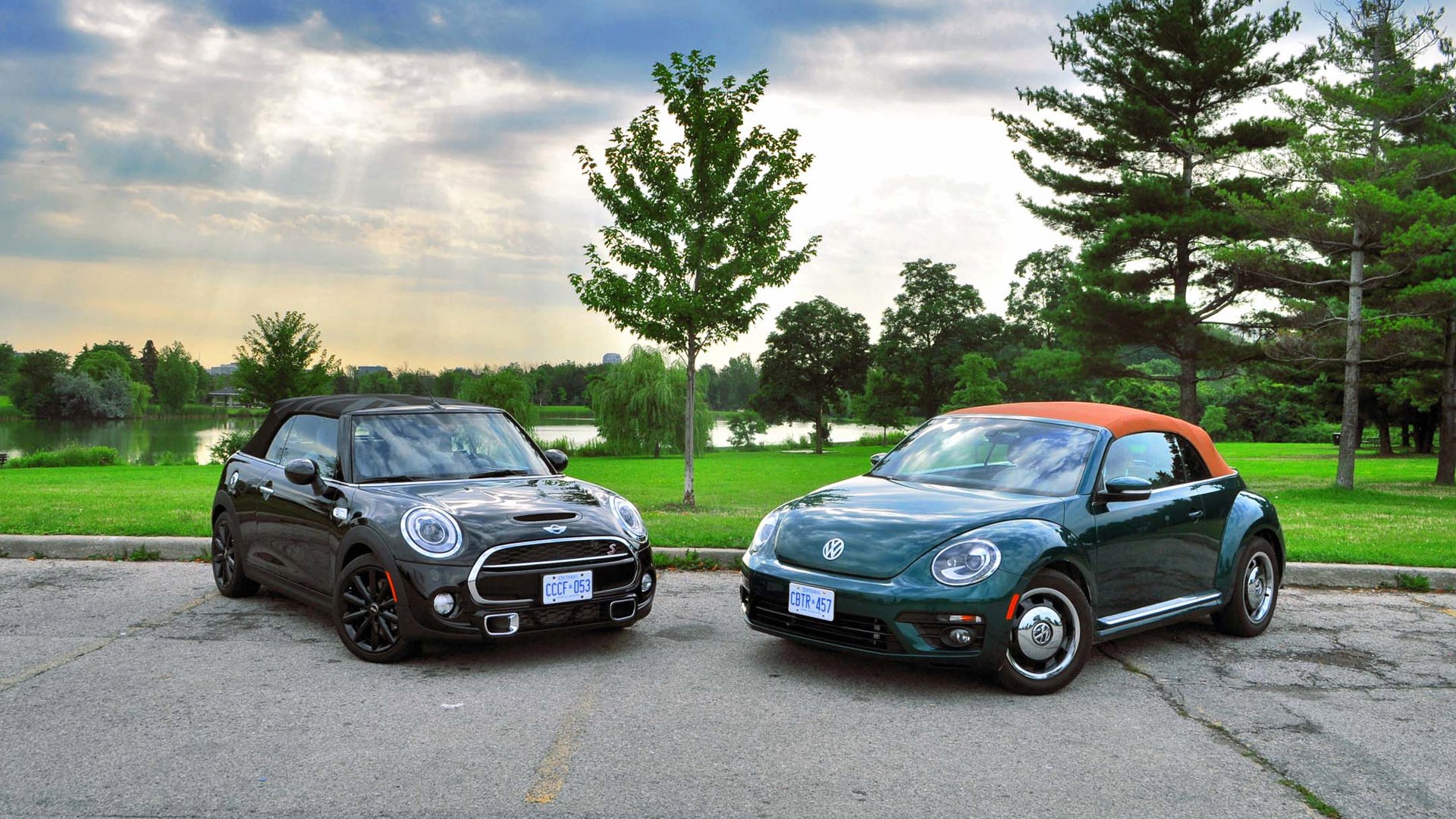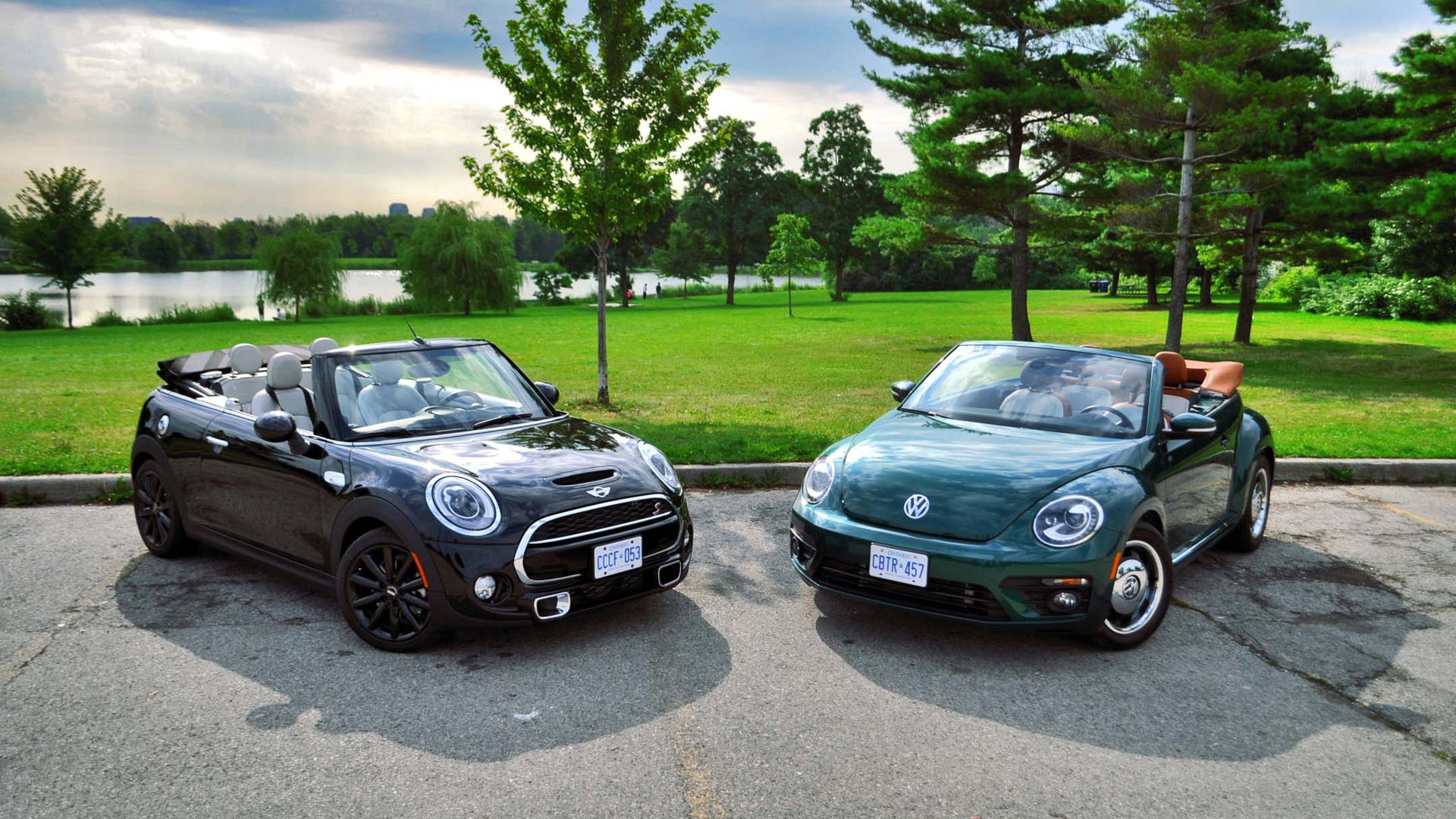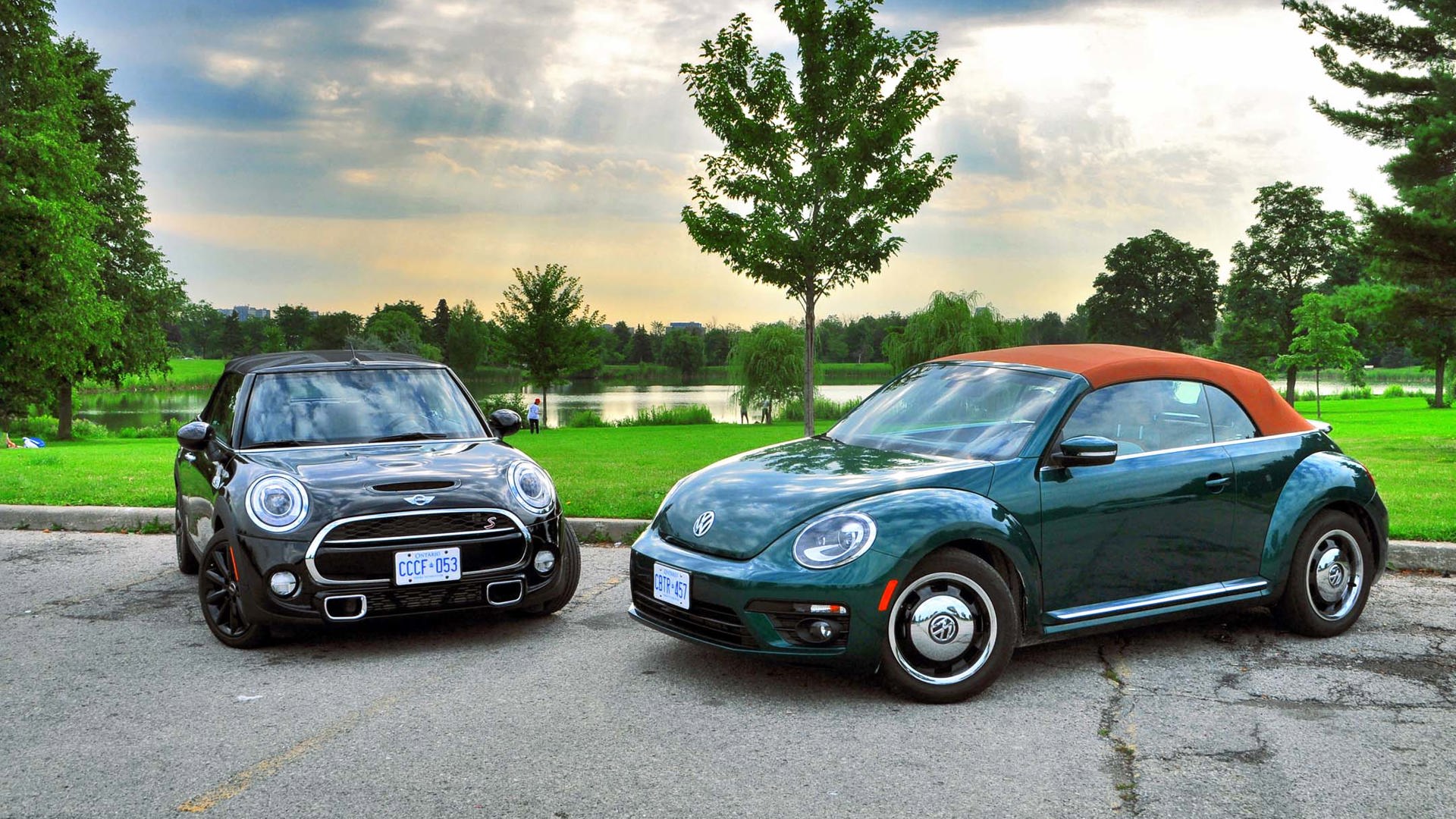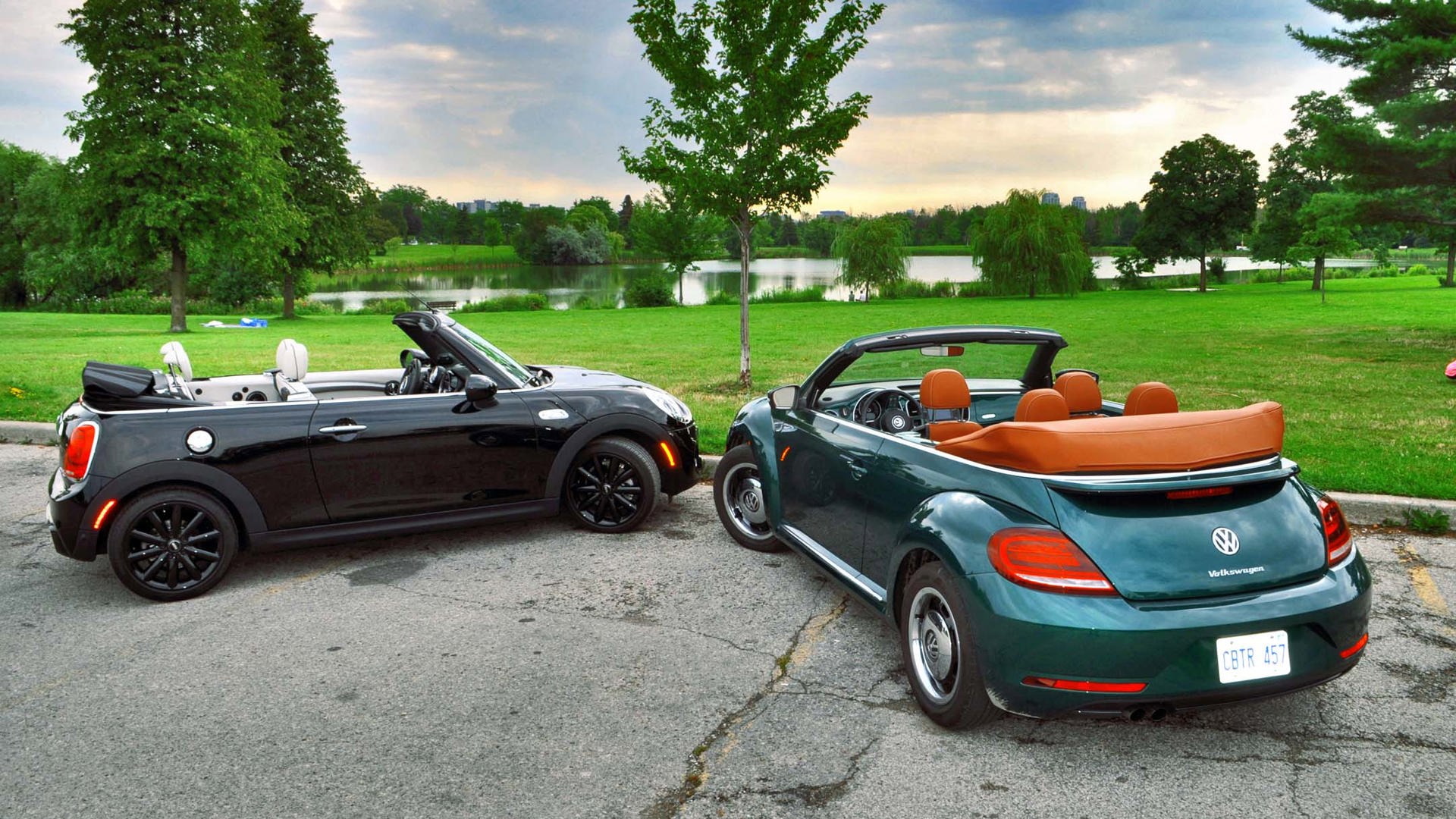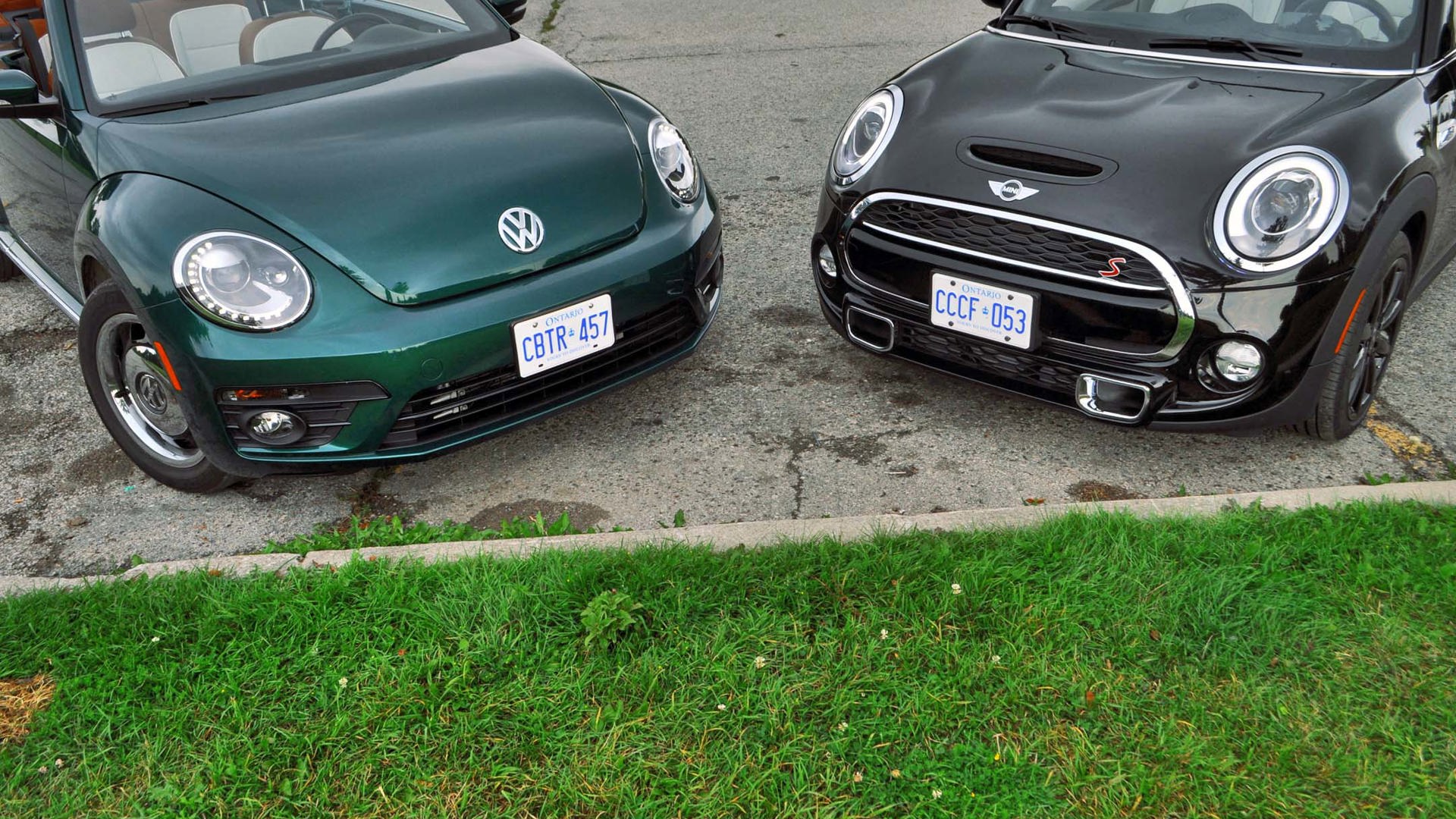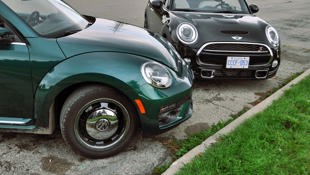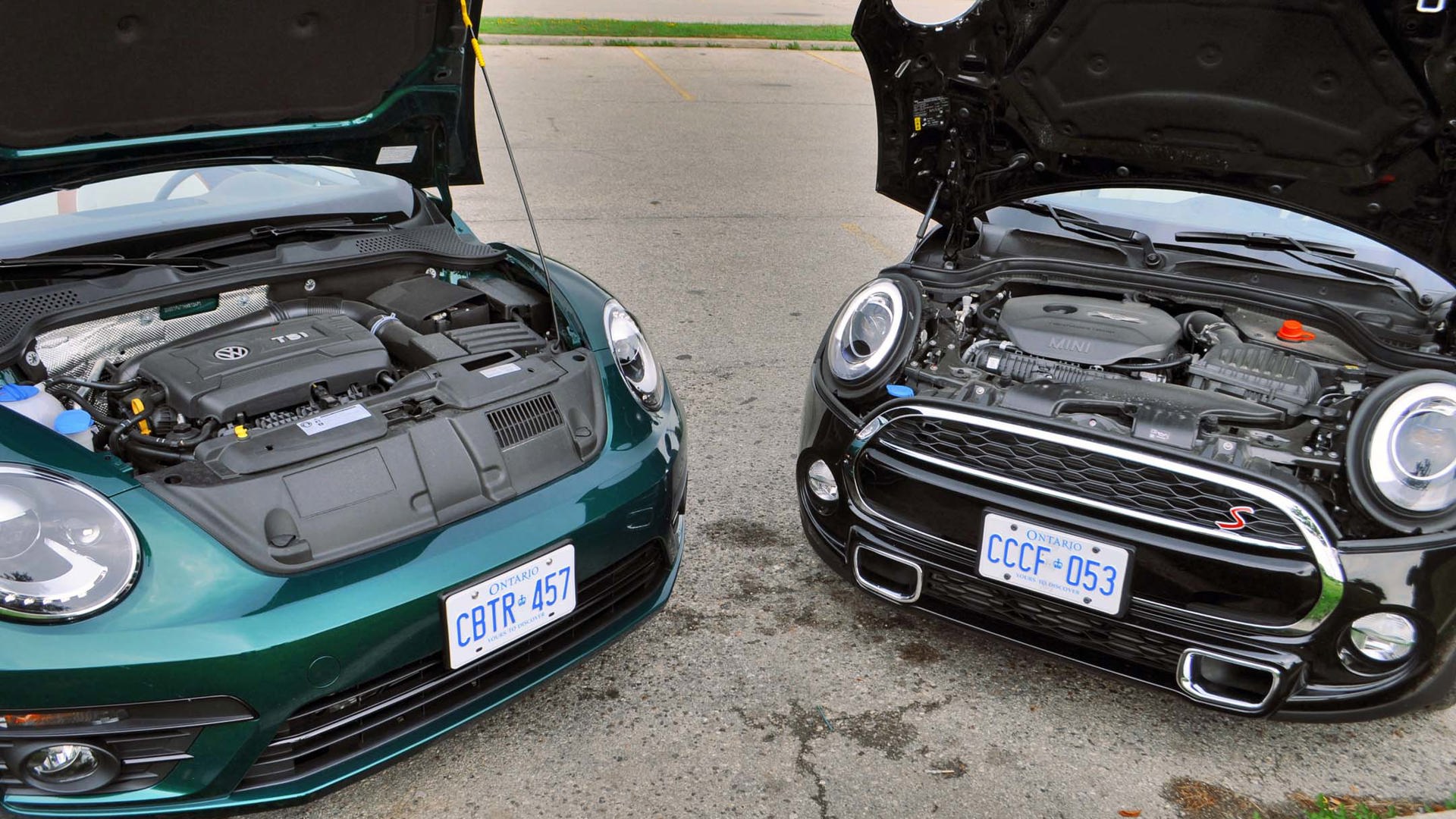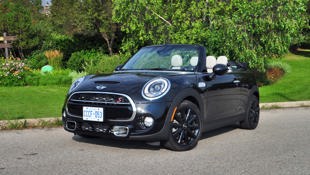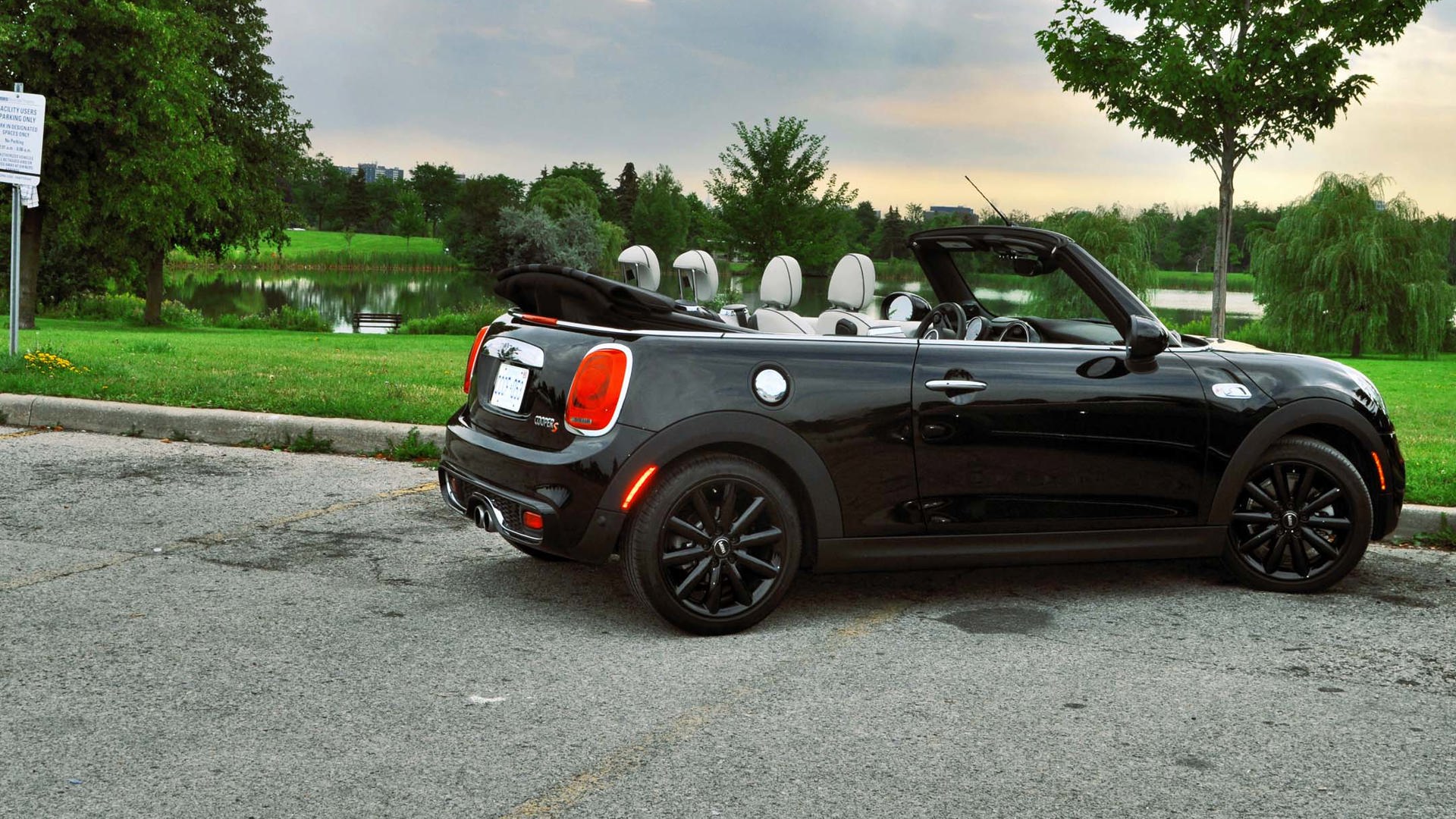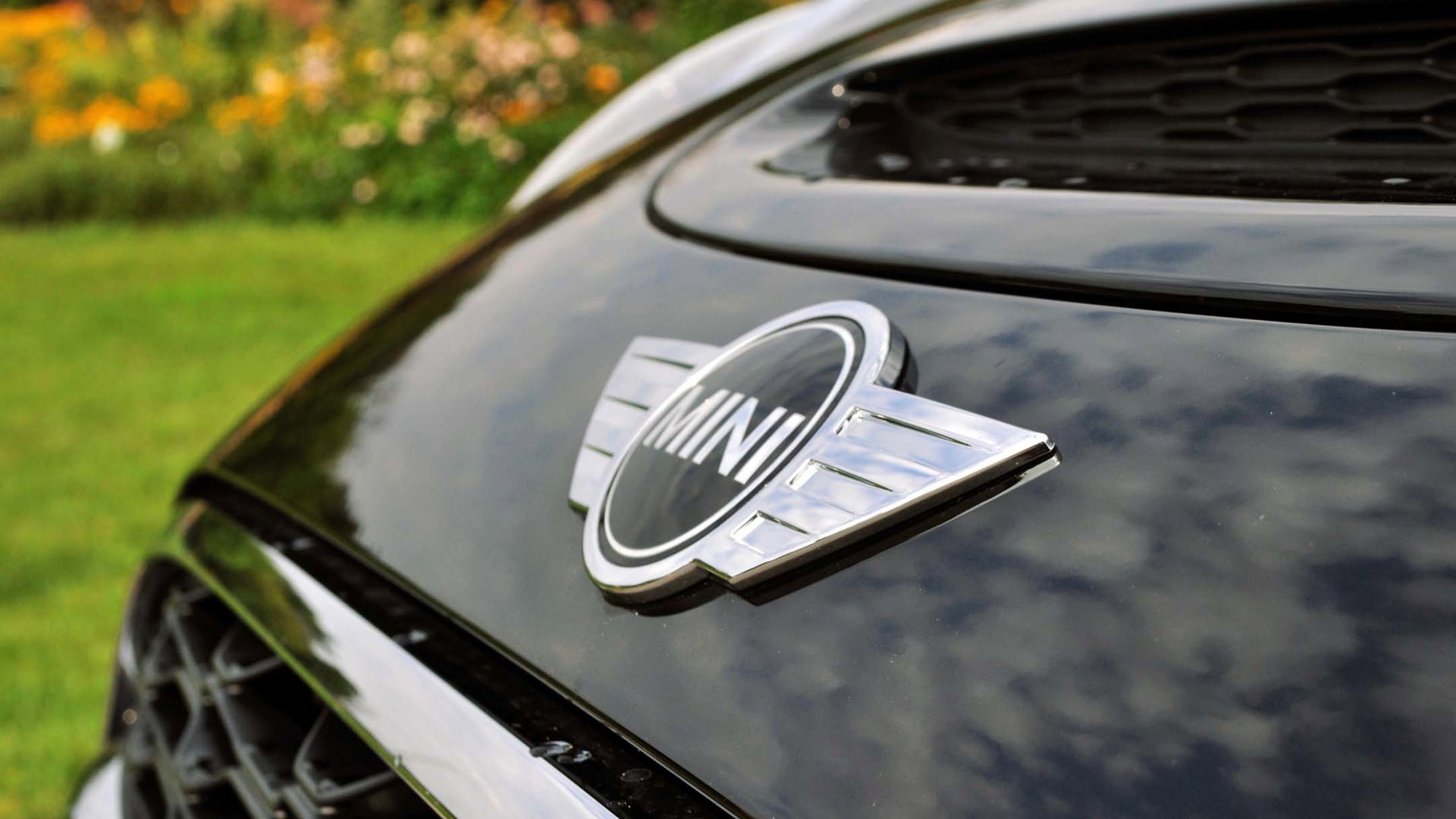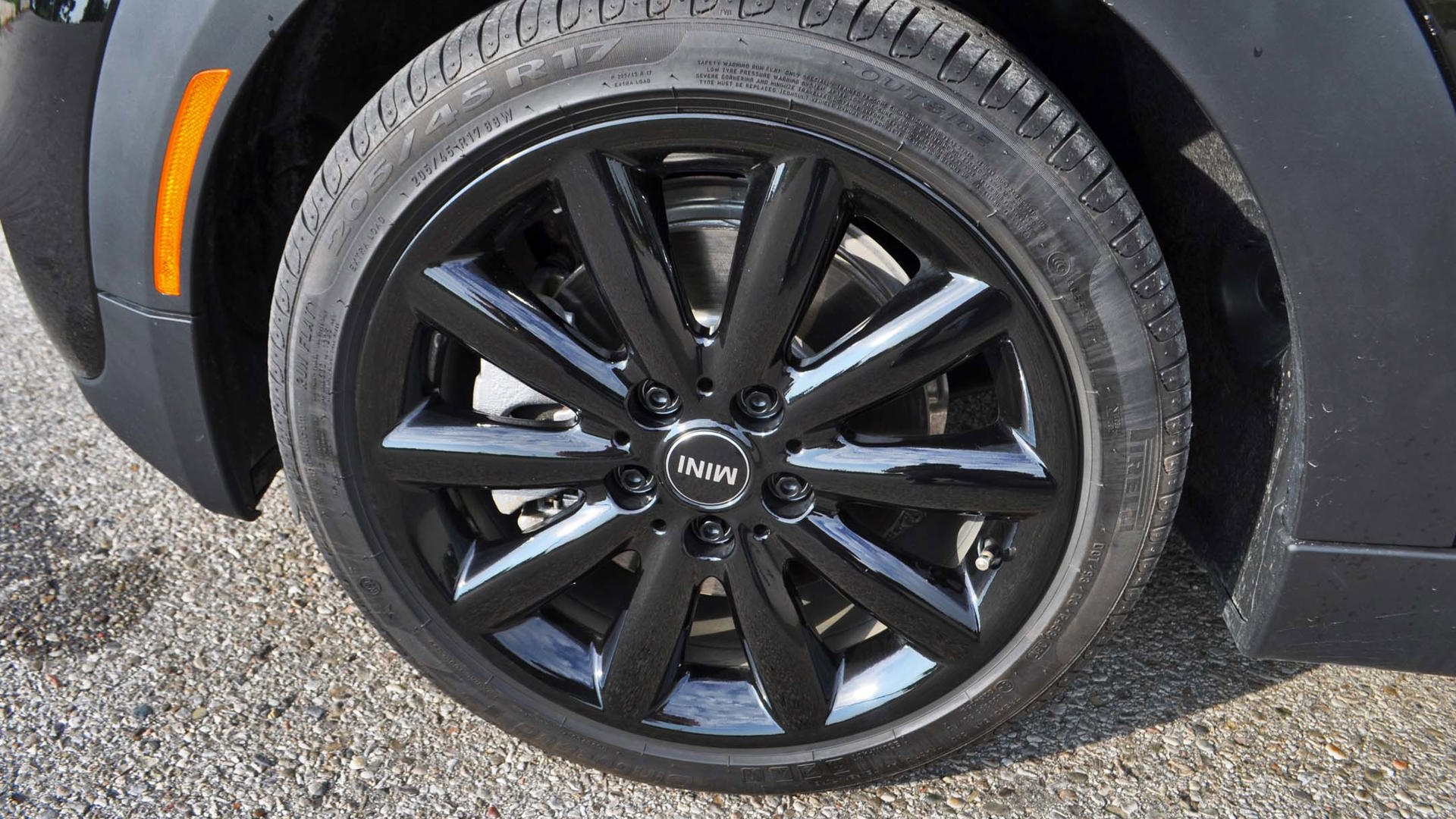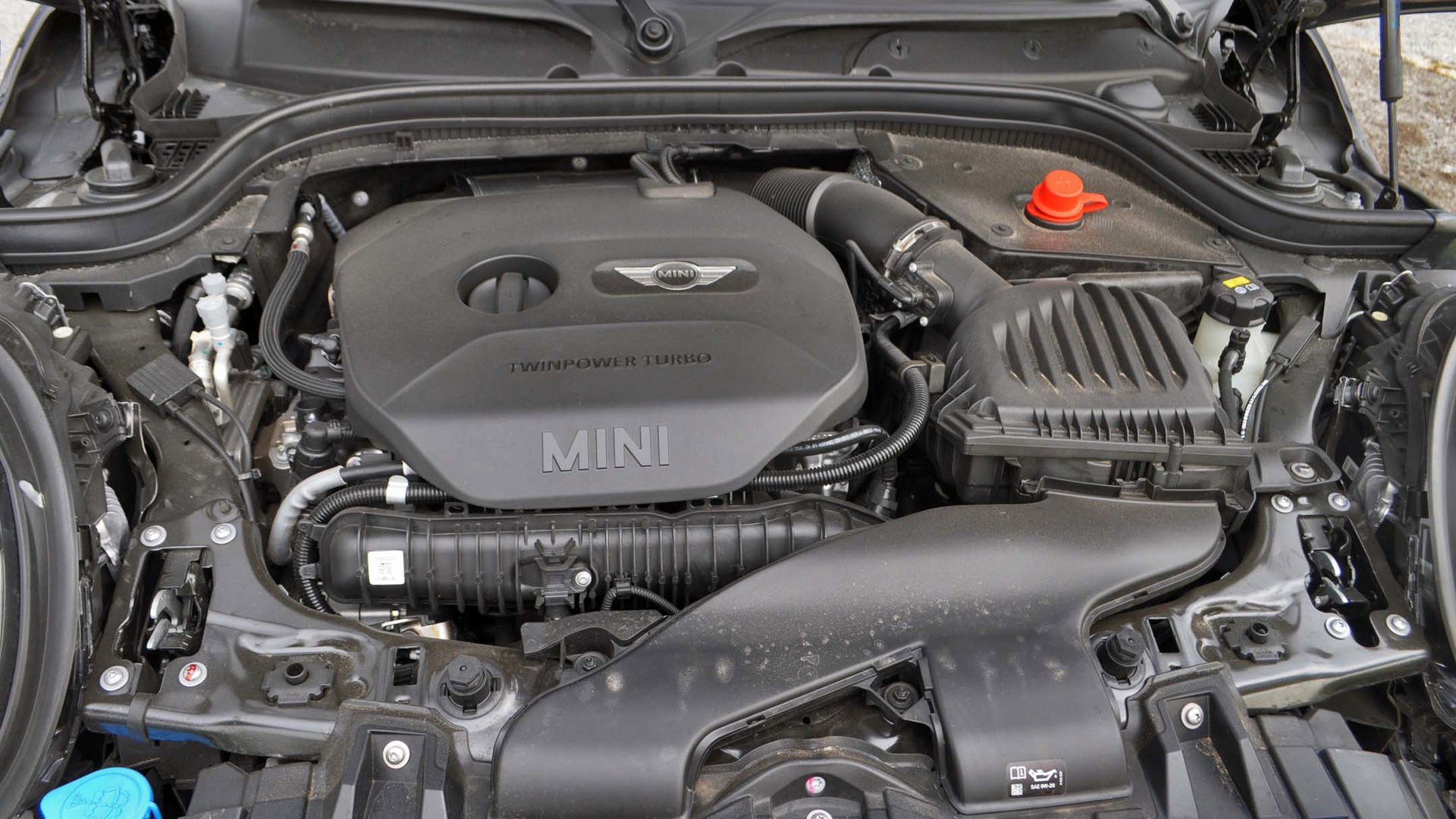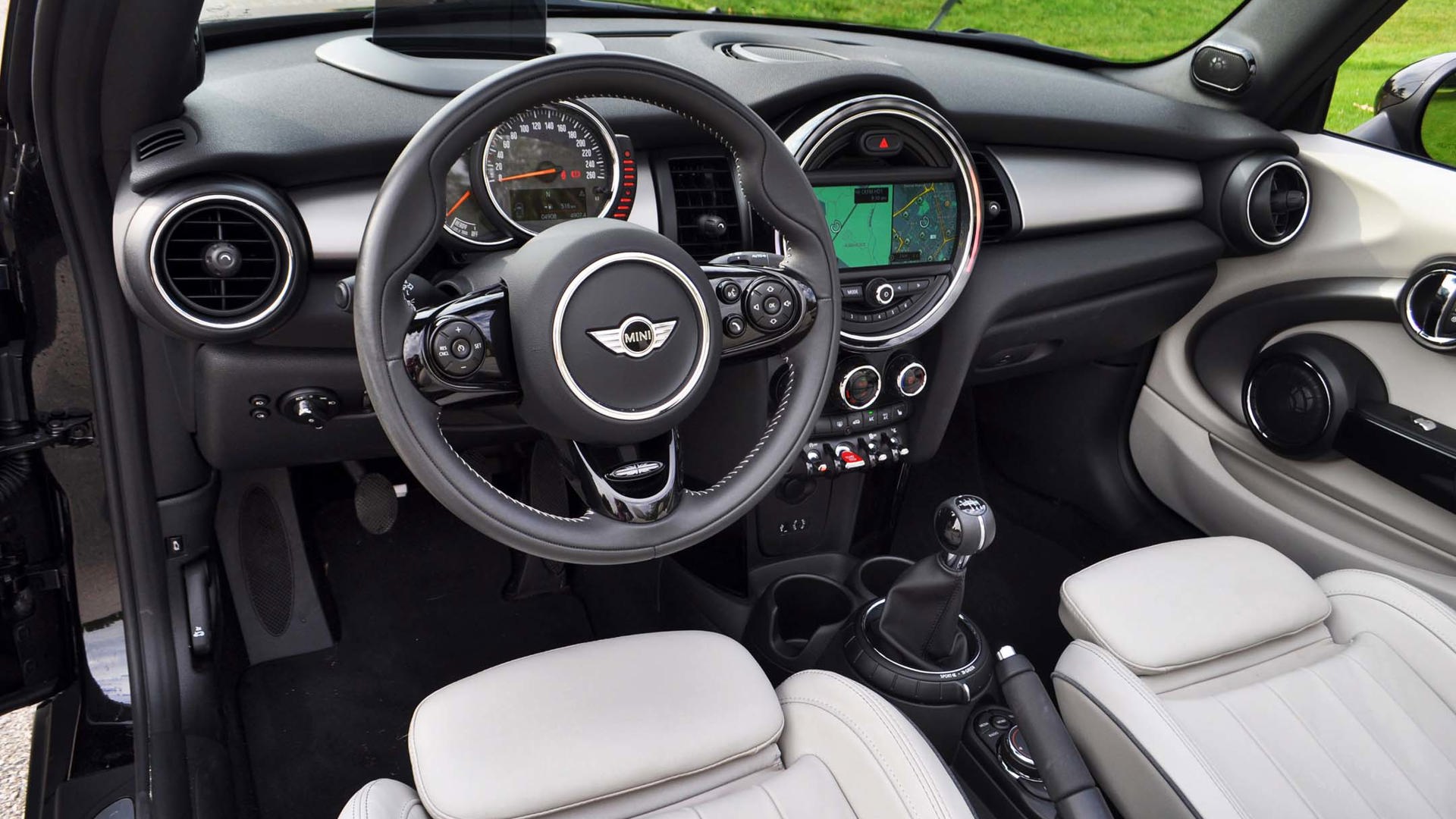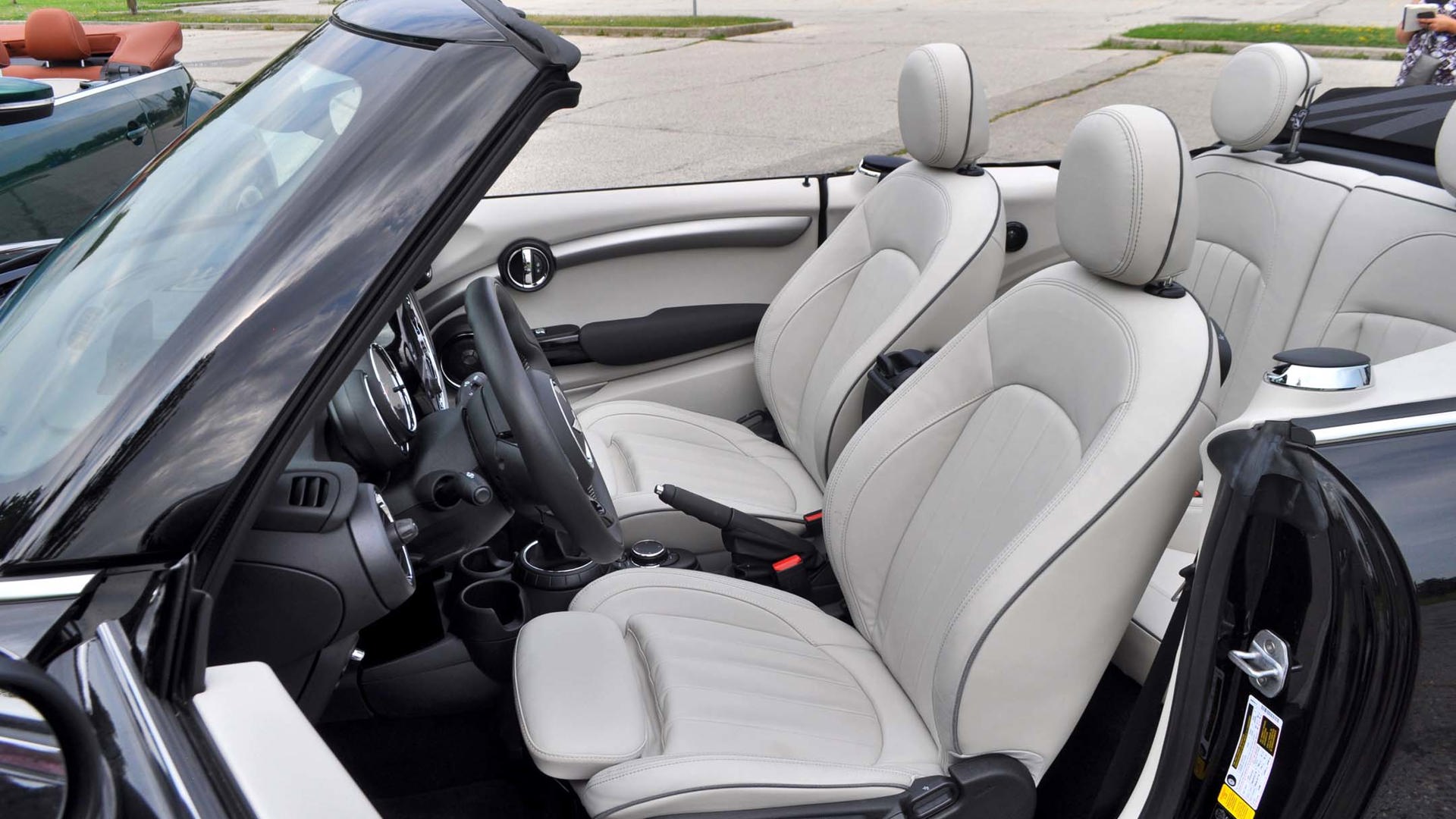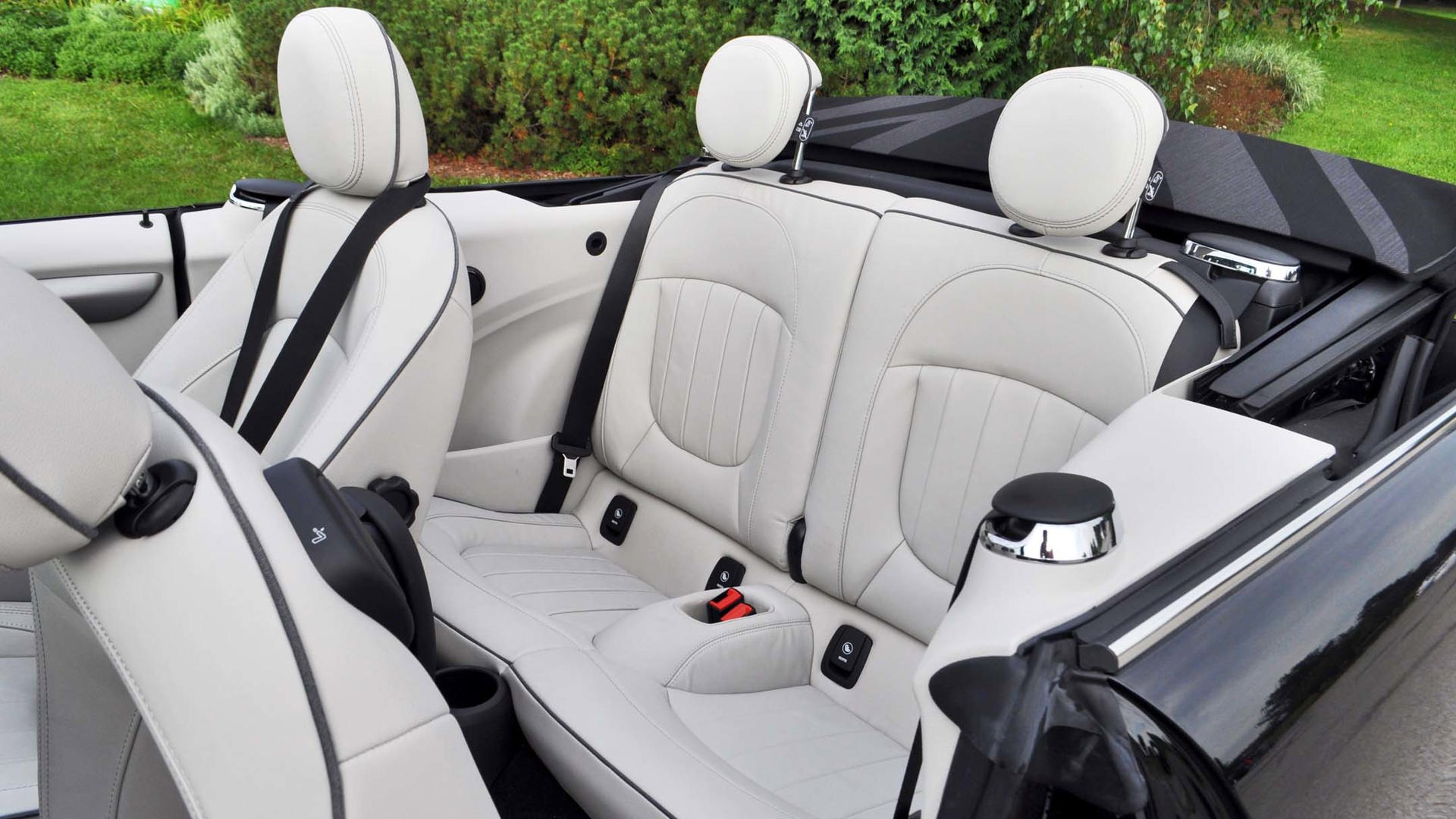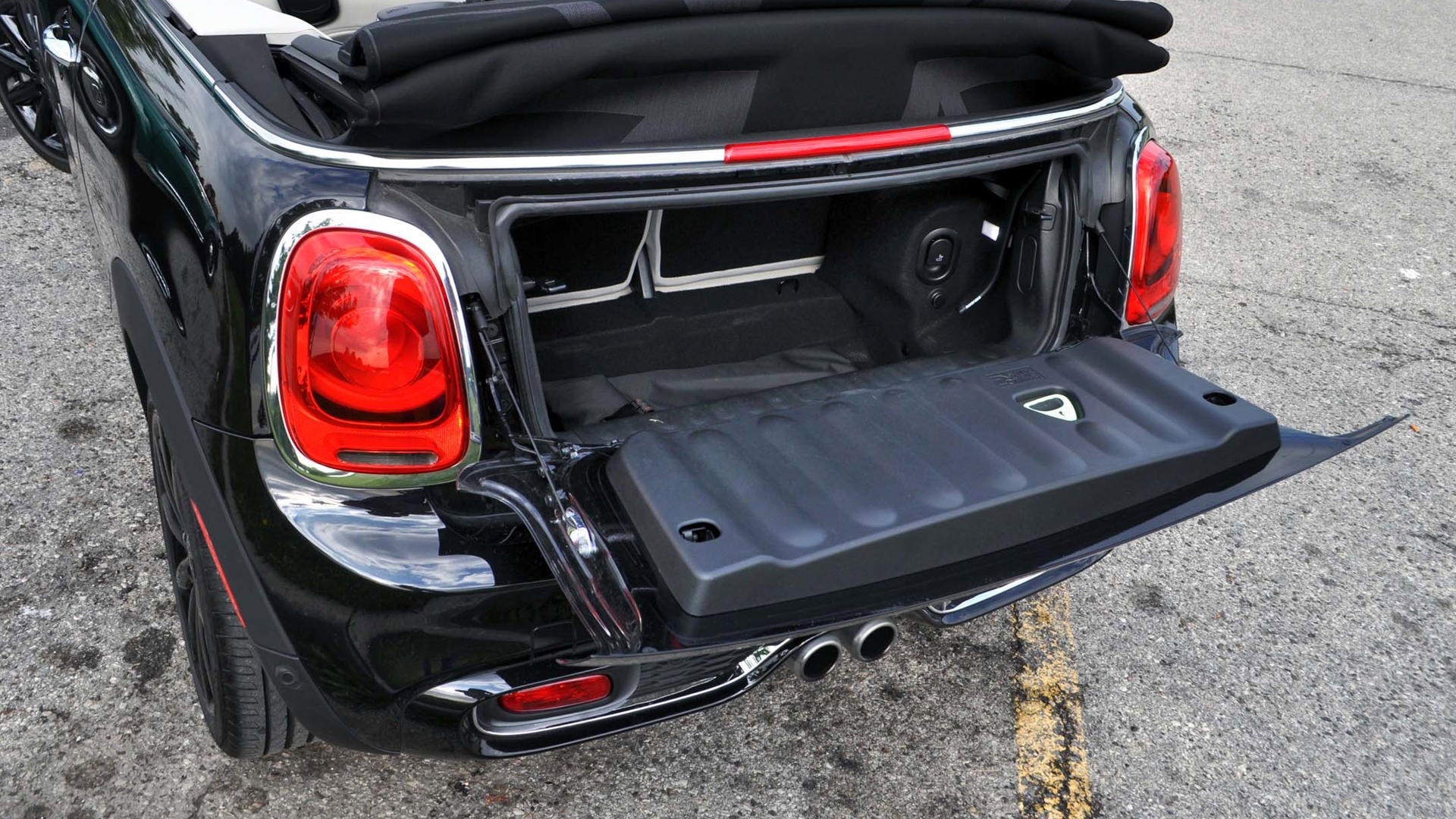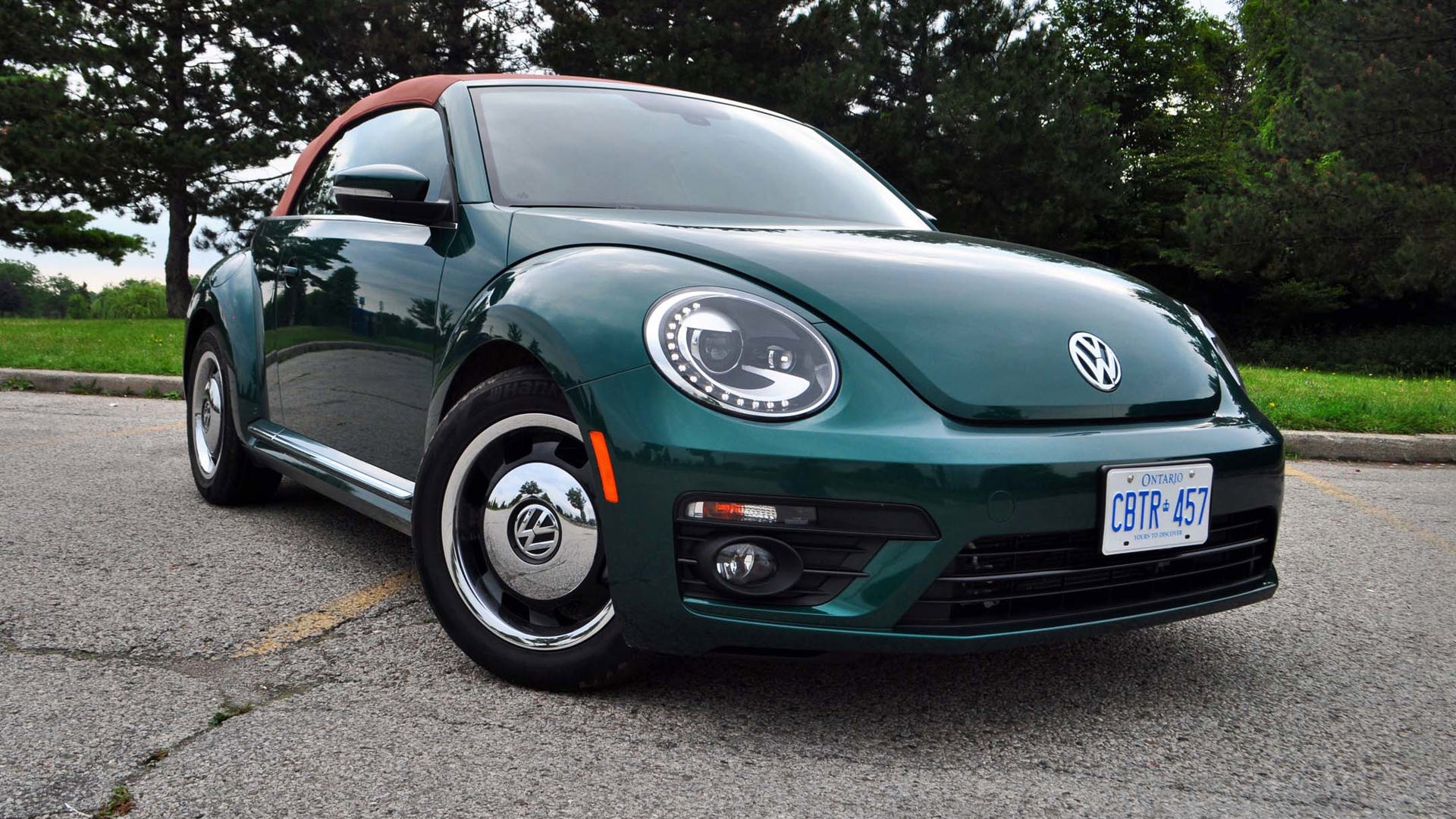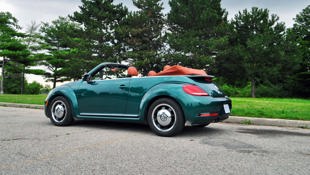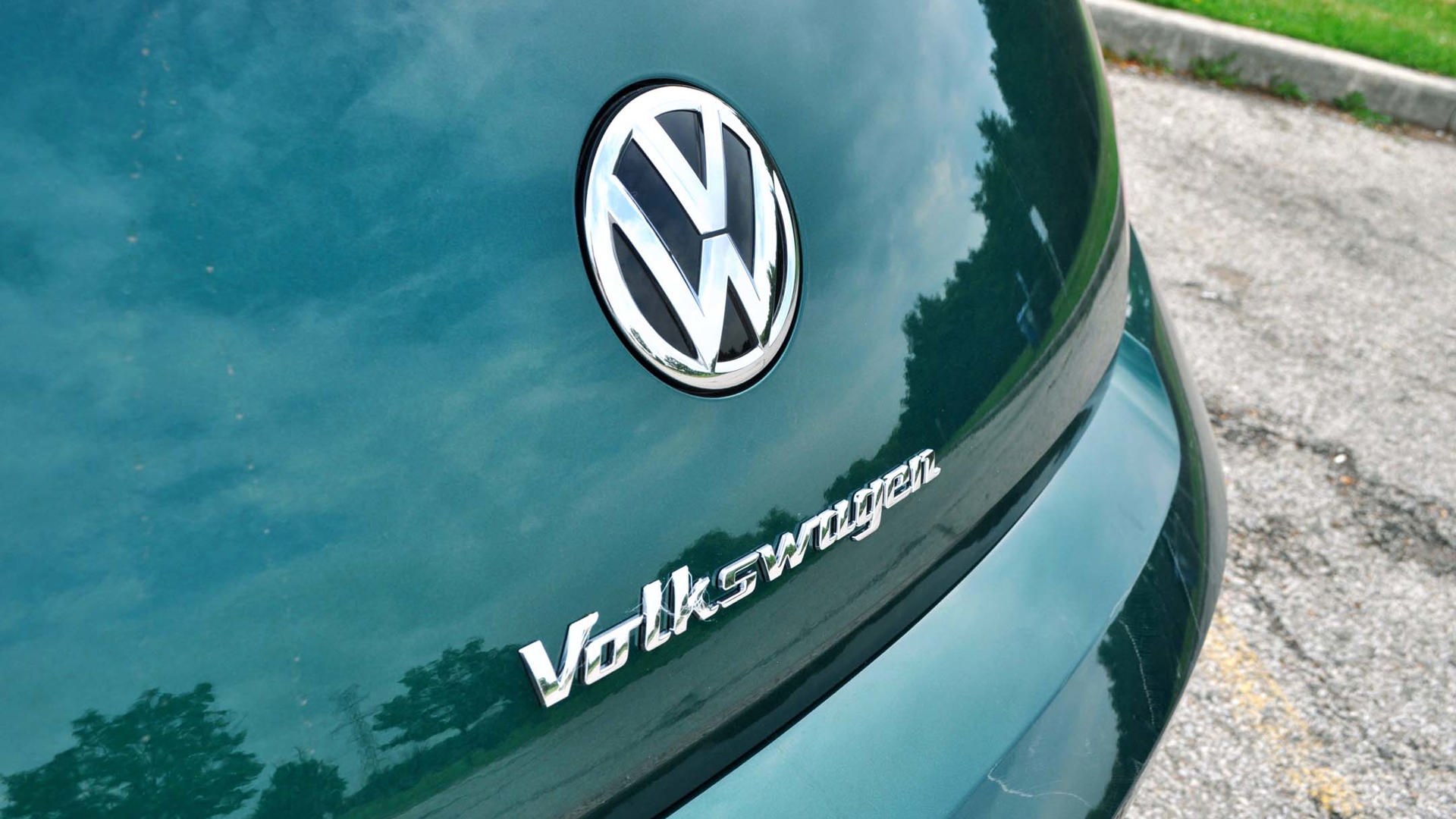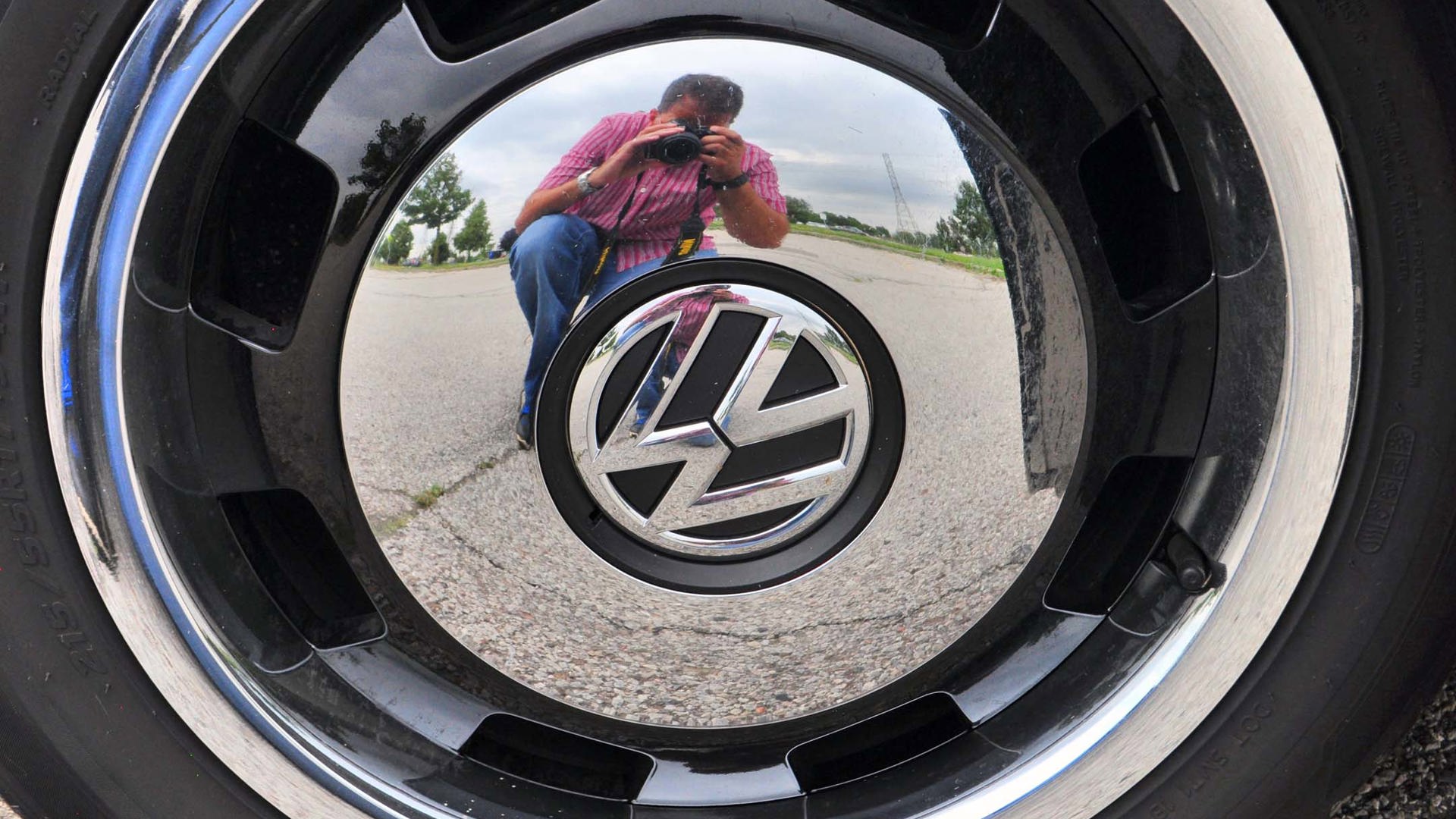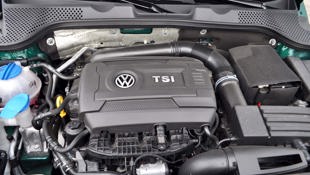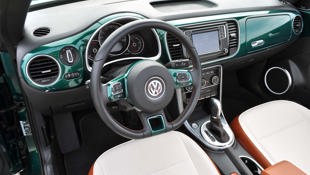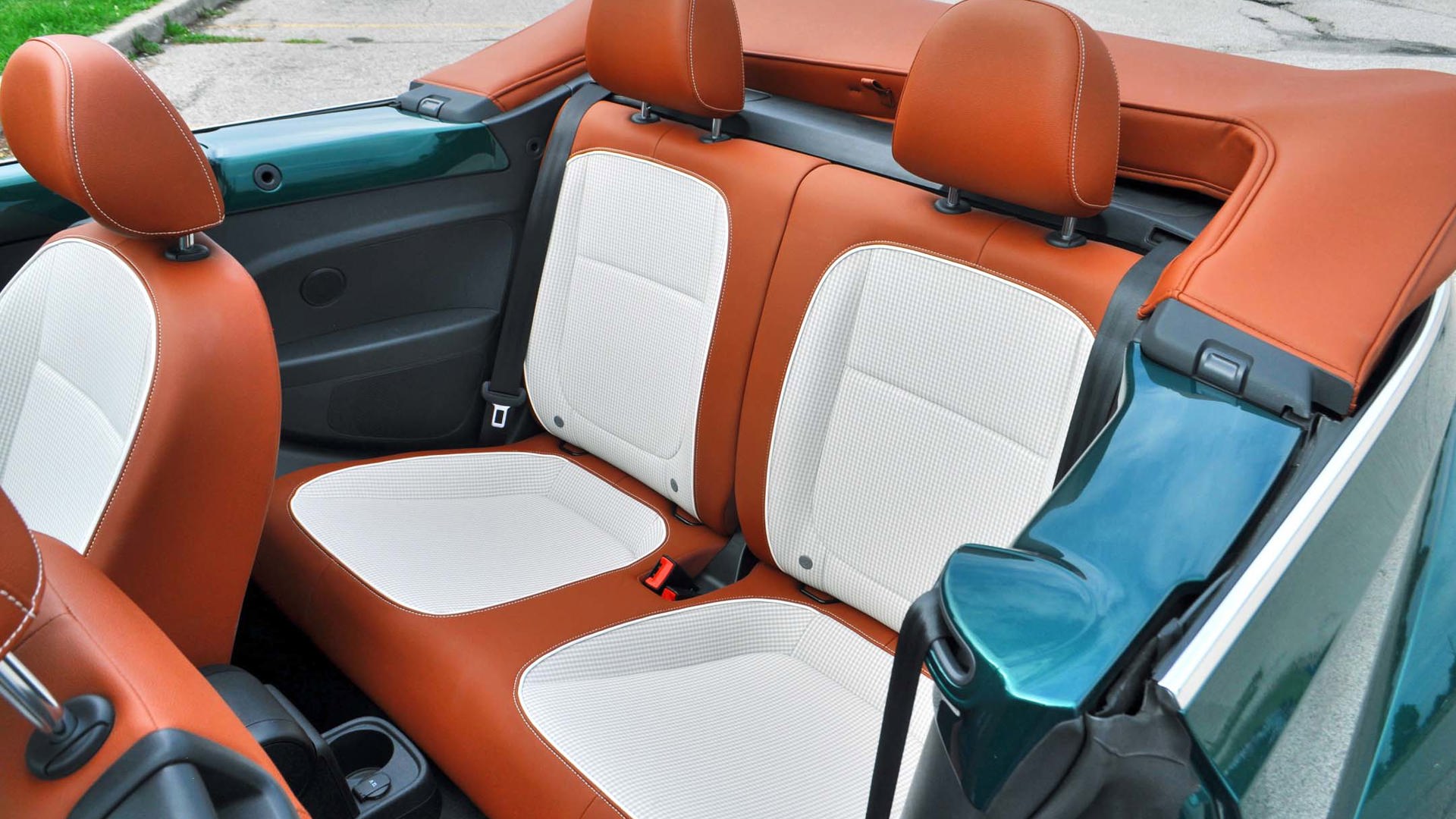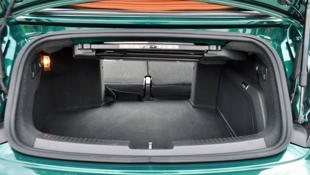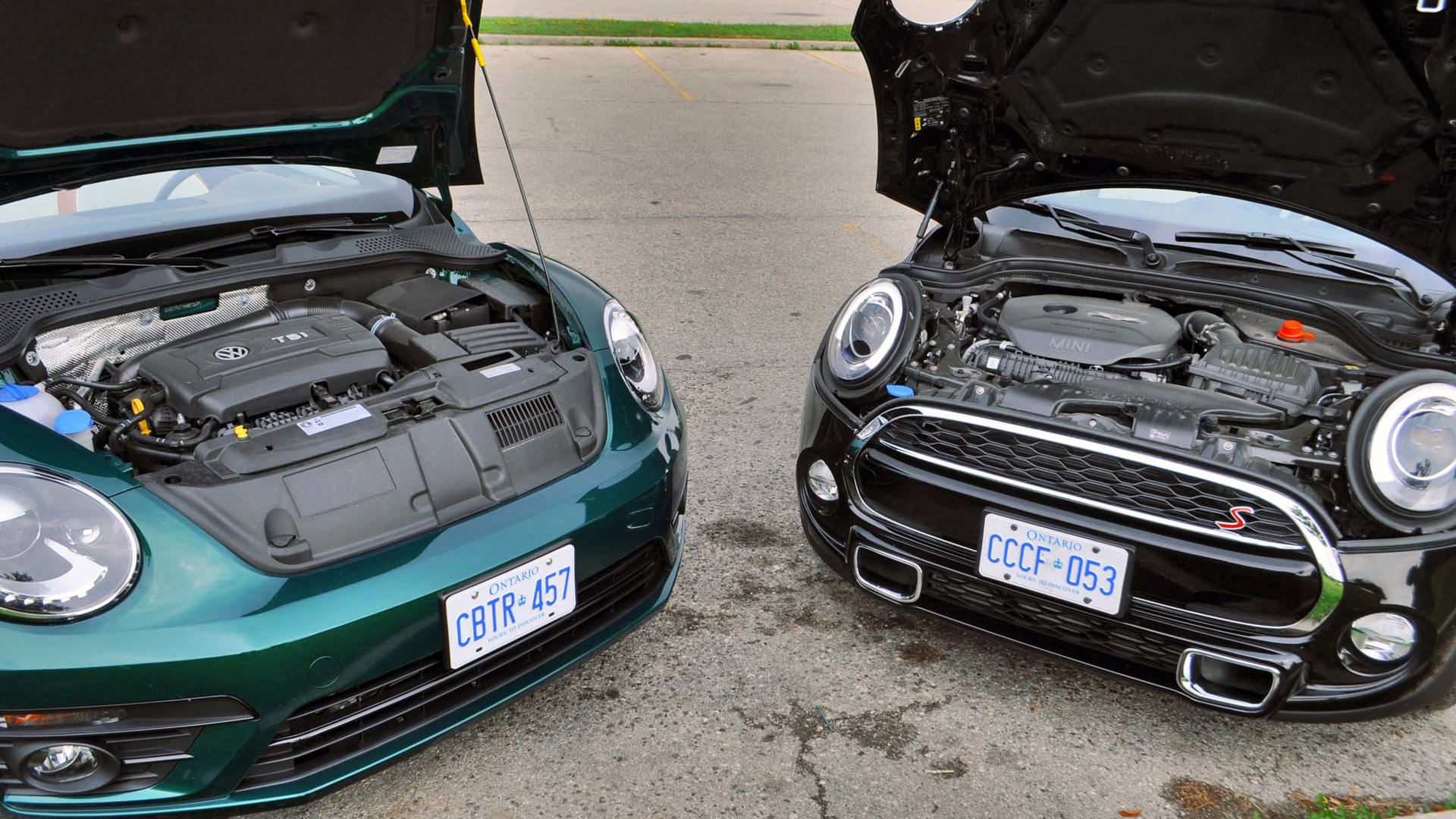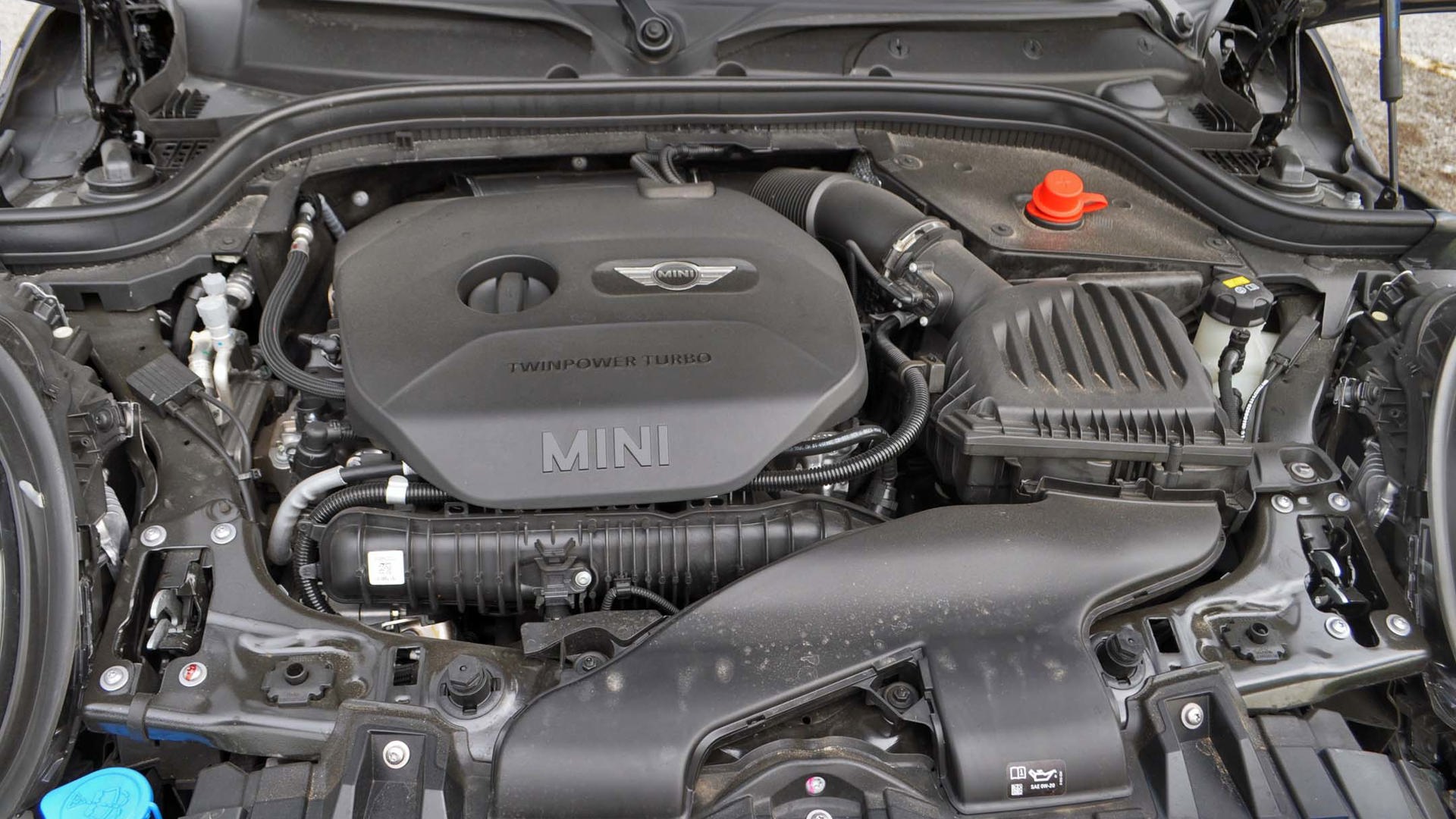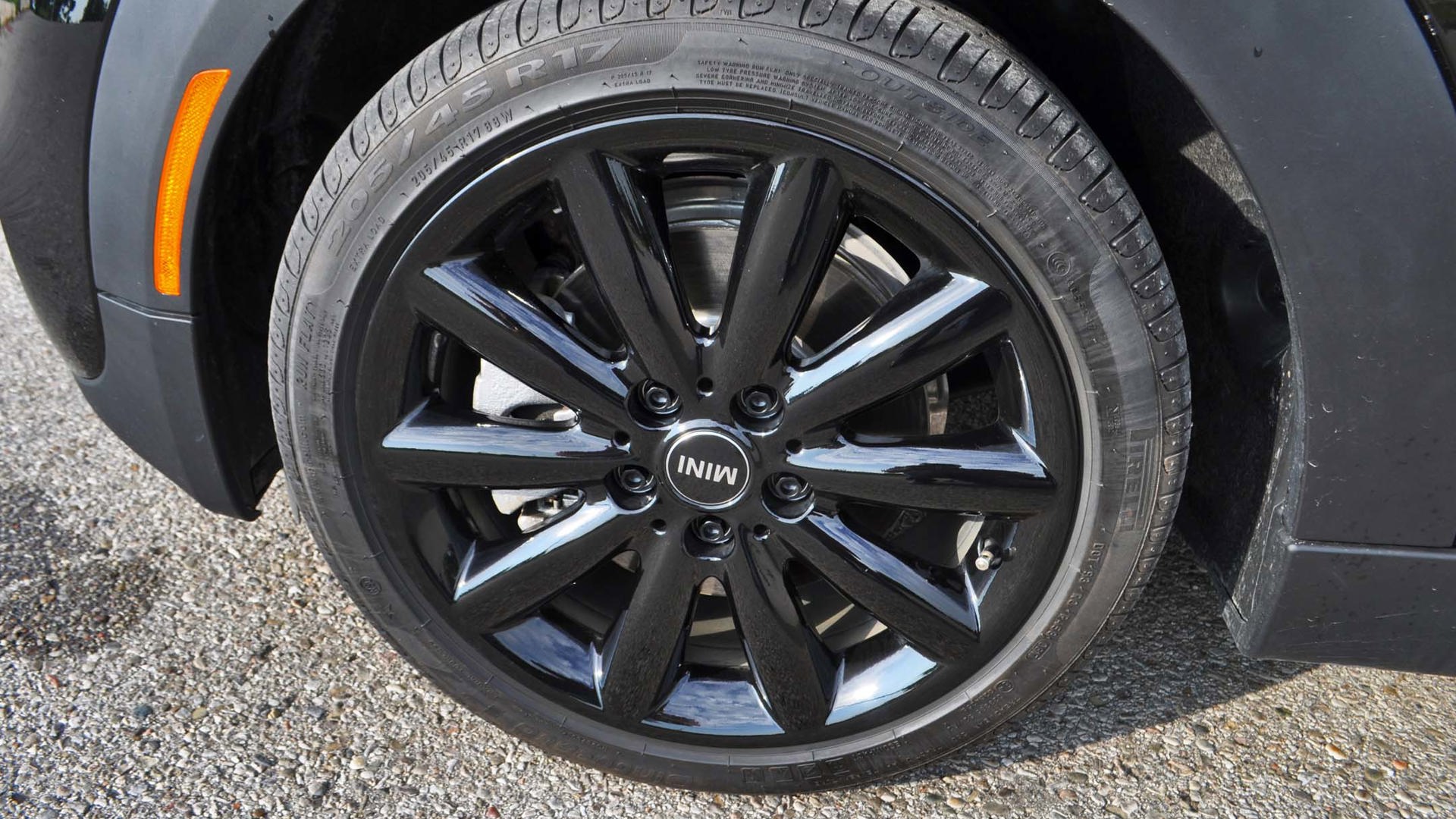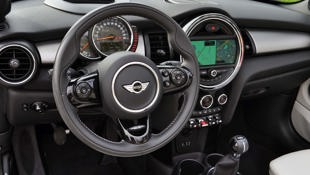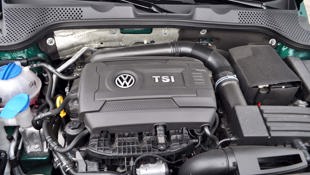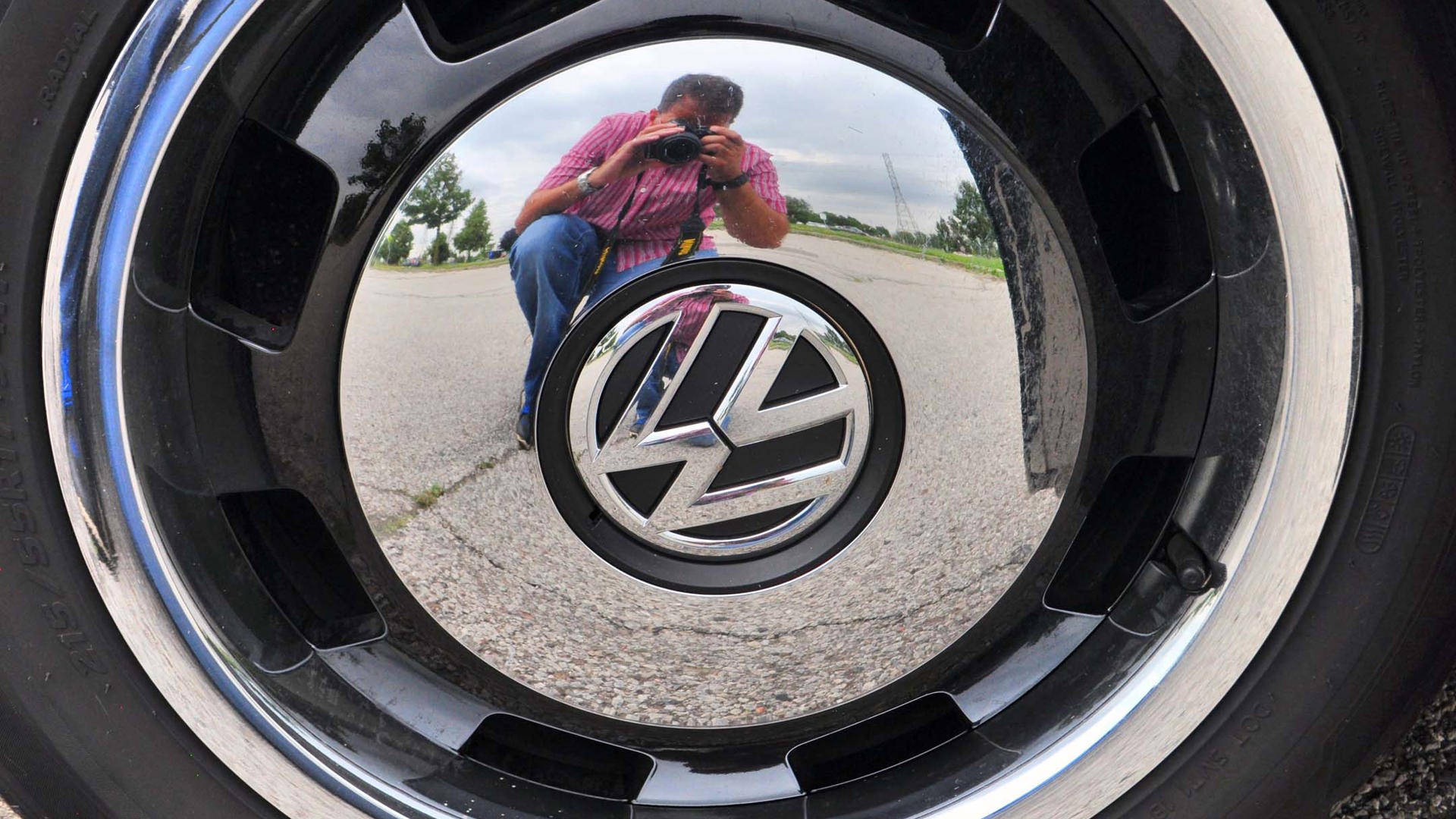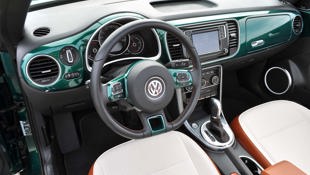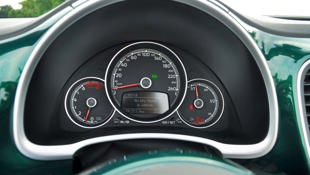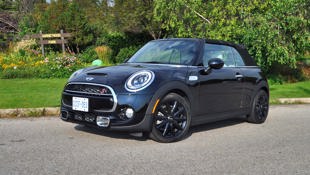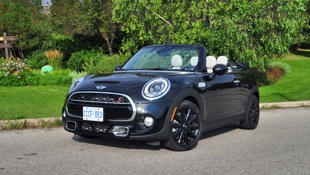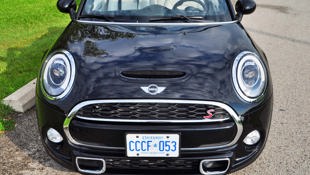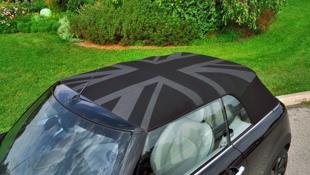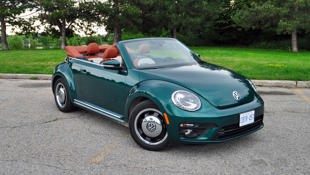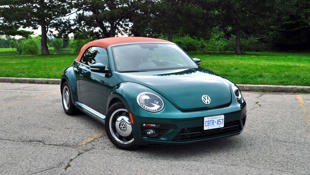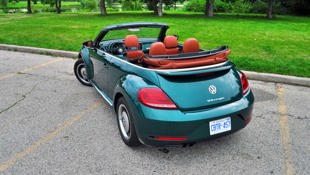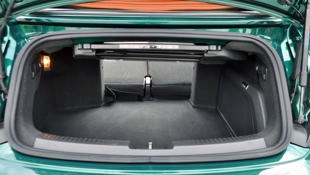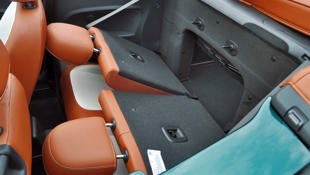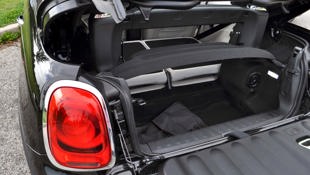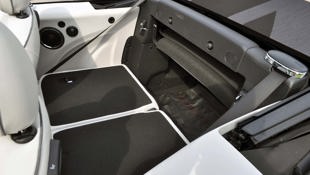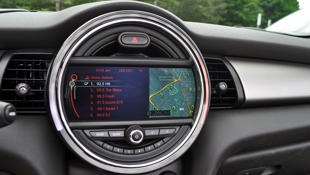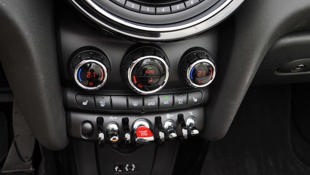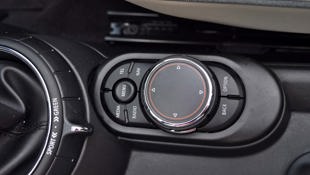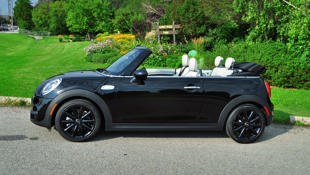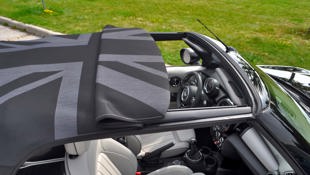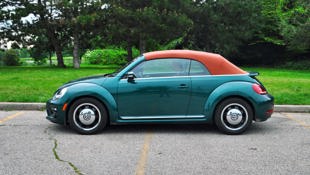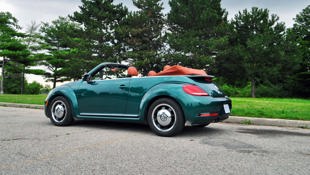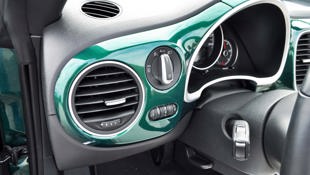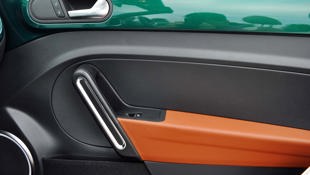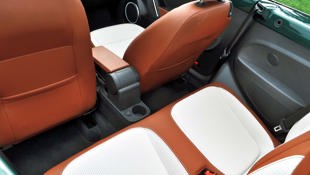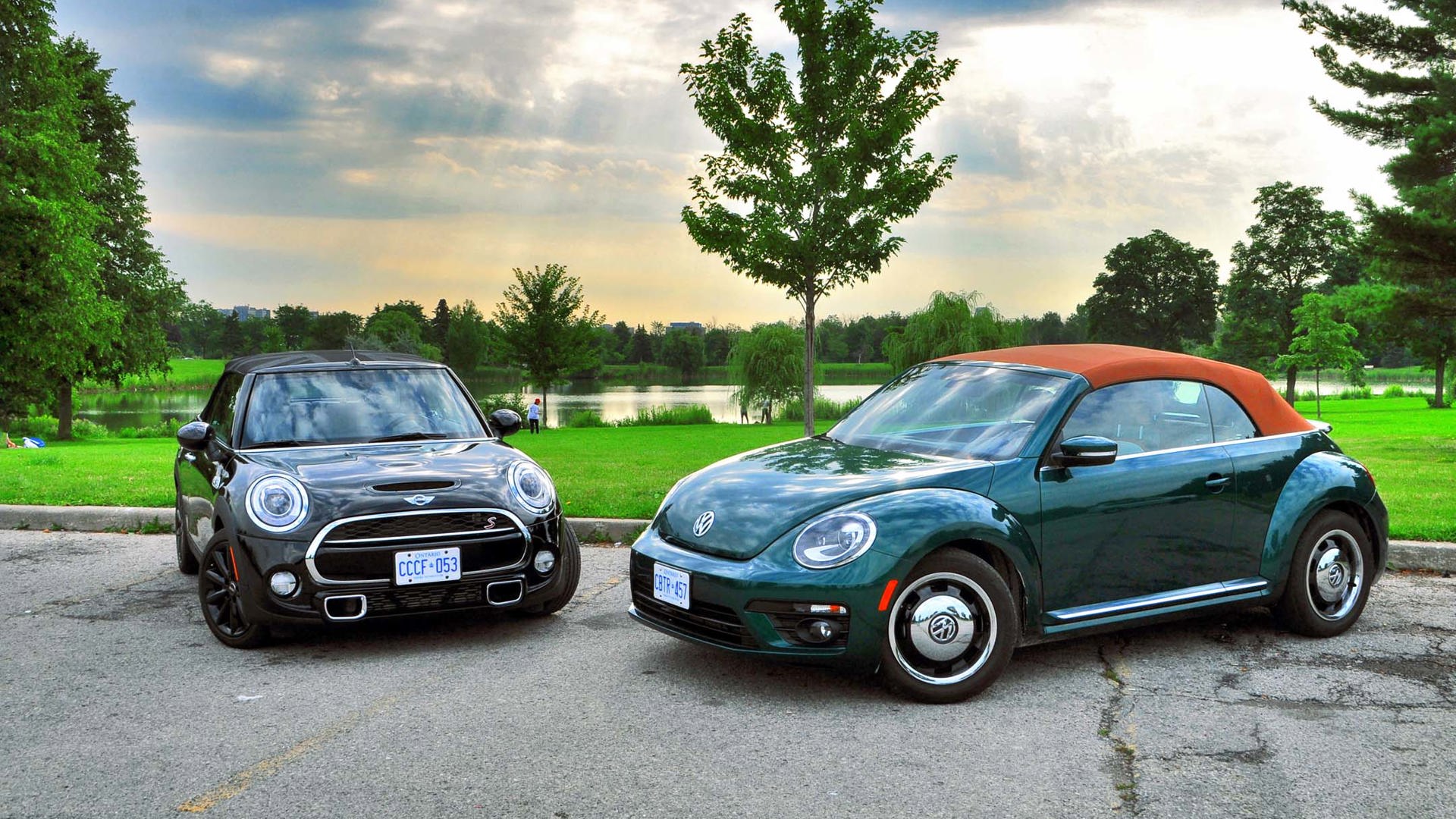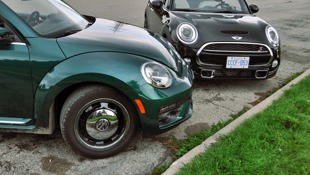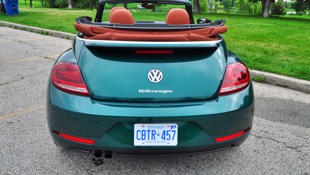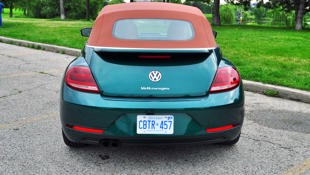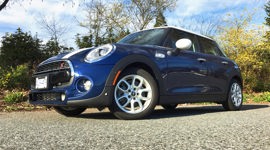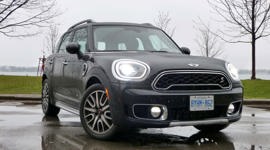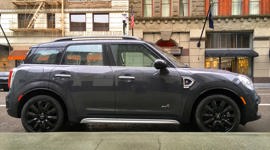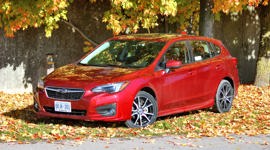Comparison Data
|
2017 Mini Cooper S Convertible
|
2017 Volkswagen Beetle Classic Convertible
|
|---|---|
|
Engine Displacement
2.0L
|
1.8L
|
|
Engine Cylinders
4
|
4
|
|
Peak Horsepower
189 hp
|
170 hp
|
|
Peak Torque
207 lb-ft @ 1,250 rpm
|
184 lb-ft @ 1,500–4,750 rpm
|
|
Fuel Economy
10.2/7.3/8.9 L/100 km city/hwy/cmb
|
9.7/7.2/8.5 L/100 km city/hwy/cmb
|
|
Cargo Space
160–215 L
|
201 L
|
|
Base Price
$32,740
|
$27,390
|
|
A/C Tax
$100
|
$100
|
|
Destination Fee
$2,245
|
$1,625
|
|
Price as Tested
$46,325
|
$31,635
|
|
Optional Equipment
$11,240 – Loaded package $1,200; LED lights package $1,150 plus $250 for adaptive cornering and white turn signals; essentials package $1,200; wired navigation package $1,000; visibility package $800; style package $550; satellite grey lounge leather $2,000; 17" cosmos spoke black wheels $800; Harman/Kardon sound system $750; metallic paint $590; soft-top Mini Yours $500; storage compartment package $250; satellite grey interior $150; performance tires $50
|
$2,520 – Style package (bi-xenon headlights with LED daytime running lights and LED taillights, blind spot detection with rear cross-traffic alert, dual-zone electronic climate control, Fender 8-speaker sound system, front fog lights, keyless access with push-start button) $2,520
|
Photos by Michael Bettencourt
Don’t you just love it when a car doesn’t take itself too seriously?
It’s time for a retro-style throwdown.
After all, amid a sea of SUVs and A-to-Bs, it can be easy to forget at times that driving is supposed to be fun.
Here’s a pair of cars designed from the drop-top down to keep that fact top of mind.
In Germany’s corner is the 2017 Volkswagen Beetle Classic Convertible. From its sable-and-green colour palette to the heritage wheels, it doesn’t take much imagination to feel transported back to a simpler time – and affordably so given that its as-tested price tag comes in at just a tick over $30,000 ($31,635, to be exact).
In Britain’s corner – which is really still Germany’s corner since Mini is part of BMW Group these days, but let’s run with it – is the 2017 Mini Cooper S Convertible. This one makes its statement right off the top with the optional two-tone Union Jack-styled roof, and it carries that 1960s chic throughout so well that if I owned one I think I’d feel compelled to buy a pair of silver go-go boots. It comes with a long list of modern amenities, though, which gives it a heftier price tag: it rings up at $43,980 as tested.
It’s time for a retro-style throwdown. Which of these cars inspired by the past is worthier of today’s dollars?
Powertrain
Cooper S: 8.5/10
Beetle: 7.5/10
As with the hard-top three-doors, the Cooper S falls in the middle of Mini’s convertible line-up. Tucked in between the base Cooper and the souped-up John Cooper Works, the Cooper S comes with a 2.0L four-cylinder twin-turbocharged engine that puts out 189 hp and 207 lb-ft of torque, the latter of which comes at a delightfully low 1,250 rpm. While an automatic is available, this one came fitted with the six-speed manual transmission. And given the nature of this car, it practically demands one. Let’s hope that never changes.
In standard drive mode, the Cooper S Convertible hums along happily with the low-rev torque and quick throttle response translating to plenty of pep under the right foot. The transmission only adds to the experience with a clear, crisp action. Drop it into Sport mode – “Let’s motor hard!” the Mini urges – and it gets even better with increased pick-up and plenty of burbles and pops. This is a most entertaining driving companion.
For the Beetle’s part, its only available powertrain is Volkswagen’s four-cylinder 1.8L TSI that makes 170 hp and 184 lb-ft of torque, the latter from 1,500 to 4,750 rpm, along with a six-speed Tiptronic automatic transmission. It’s no slouch, mind you: it may be a little more noisy and less in a hurry, but both the engine and transmission are very smooth and refined. I found I was often in a higher gear than I wanted when searching for some spirited driving, but sport mode made for a slight improvement and rowing my own with the Tiptronic, naturally, solved the problem entirely.
autoTRADER.ca’s Managing Editor Michael Bettencourt, who joined me on this test, was a little more critical of the Beetle’s mill: “Driving around the syrupy-slow Beetle convertible ain’t the most masculine feeling in the world,” he said.
On its own, the Beetle is pleasant to drive. Put it back-to-back with the Mini, though, and the little British dynamo’s character shines on like a crazy diamond.
In fuel economy, the Beetle is rated by Natural Resources Canada to use 9.7 L/100 km in the city and 7.2 on the highway. Fitted with the manual transmission like this one, the Cooper S is thirstier at 10.2 and 7.3; however, with the automatic transmission the figures are much closer to those of the Beetle at 9.4 and 7.2.
Drive experience
Cooper S: 8/10
Beetle: 7.5/10
The comments made above carry through to a discussion of handling. The Beetle is staid, predictable, and goes where you point it, but couldn’t be described as especially dynamic. The Cooper S, on the other hand, has that unmistakeable Mini go-kart-style handling – it grips and hangs on and seems to taunt you to try a little harder. (I do need to note, though, that the dynamic damper control that aids this is part of the loaded package, which runs you an extra $1,200.)
“Entertainment-wise, it’s responsive: the quick steering has you easily adjusting your on-ramp lines, and the manual transmission has pedals perfectly aligned for easy heel-and-toe downshifts,” Bettencourt says of the Cooper S. “After hopping out of the zippy Mini, the VW feels like it’s constantly starting in second gear, with little initial throttle response and a fair amount of turbo lag from its 170 hp engine. It sounds like it’s generously rated, or it’s heavy, or the auto transmission saps much of the response and fun out of it. And where are the shift paddles?”
Where convertibles can sometimes vary widely is in visibility. These two are similar in some ways – neither of them makes it especially easy to see rearward over a retracted roof, for instance – but they differ in two notable ones. Taller driver may find that they prefer the windshield roofline on the Beetle, which offers a couple of inches of extra visibility. And back to the rearward view, the Mini’s is quite a bit better: the second-row headrests in the Beetle are larger, which extends the blind spot down either side by a greater margin. (If you plan to drive around without the headrests installed most of the time, this point is moot.)
One surprising difference in these cars is in structural rigidity. The Cooper S has a fair amount of give and does a lot of shaking and rattling over bumps, especially through the windshield. The Beetle, on the other hand, is rock-solid and thoroughly composed. And of these two cars, it’s also got the quietest interior with the roof up.
Styling
Cooper S: 9/10
Beetle: 9/10
In the context of what they’re trying to achieve, I think each of these cars hits its styling marks very well.
Both set the tone as soon as they pull up: the Mini with its classic headlamp and grille configuration, made even better by the optional unapologetic Union Jack roof design, and the Beetle with its signature hood line and heritage wheels. If you’re an enduring fan of either of these cars, you can’t help but smile when you set eyes on your favourite.
Bettencourt was especially taken with the Mini’s interior: “It has all kinds of character with retro chrome rocker switches, but also a cool red start/stop switch that glows bright red when it’s ready to start, i.e. when you have the clutch in on this manual version,” he said. “Mini has by far the more modern interior as well, with a whimsy of fun, especially with its LED light ring around the stereo system that adjusts with the volume and climate settings.”
This Mini had its price tag upped with all-leather upholstery ($2,000). The seats are comfortable and have added hip supports – although it’s a little surprising that the seat adjustments are still manual in a car that’s over $40,000.
The Beetle has two-tone seats with leather edging that matches the roof, lined with cloth inserts, and the checkered pattern on the fabric offsets this car’s look perfectly. Between that and the continuation of the car’s exterior colour throughout the cabin, I find that this interior is packed with charm.
On the latter point, Bettencourt was less enamoured. “The fabric seats with tan accents are lovely and comfortable, but the colour-matched green dash panels – including green steering-wheel accents – have an air of perhaps a little excessive effort to do something different. And they bring to mind the little-lamented Chrysler PT Cruiser.”
Though the Mini’s steering wheel is beefier and more substantial to grip, the Beetle’s thinner wheel design just feels right for a car that’s unapologetically vintage-inspired.
Both cars have quirky circular-themed gauge clusters, though the Mini’s has a more modern look with higher-resolution screens in the gauge cluster. It also shifts up and down as the steering wheel is adjusted, though I found that I still can’t quite see the top of the speedometer when I have my short-limbed self in my ideal driving position; however, the head-up display (an $800 option) solves the problem. I can’t see the top of the speedo in the Beetle, either, and in that car there’s no way around it.
The Beetle wins by a mile in rear-seat room in that it’s actually usable, though fitting four adults would still be a tight squeeze. In the Mini, the second row is more of a formality, and you wouldn’t want to put any but the tiniest humans in there very often. (Though if you do have tiny humans to drive around, the Mini is much friendlier for installing car seats.)
Storage
Cooper S: 7/10
Beetle: 6/10
Neither one of these cars is great as far as in-cabin storage goes, which is a shame because tucking away doodads and papers and things tends to be much more important where convertibles are concerned. That said, the Mini actually has map pockets on the front-row doors, whereas the Beetle doesn’t have much more than an elasticized strap that I wouldn’t trust to hold much very securely.
Both cars also have tiny trunks, as is to be expected when room needs to be left for roofs to collapse into. The space in the Mini is a bit smaller – 160 L to the Beetle’s 201 L – but it’s chock full of tricks to make that space more accessible. While the Beetle’s trunk comes with nothing more than a lid, the Mini’s door drops downward to create a loading shelf that can hold up to 80 kg of weight, and there’s a lever system to lift the top up as well so that bulkier items can be dropped in from above.
Infotainment and connectivity
Cooper S: 7.5/10
Beetle: 8.5/10
The Cooper S’s infotainment system, logically, uses BMW’s one-handed input device located just below the shifter. I tend to prefer this input style because I find it the easiest to navigate without having to look down (and away from the road) to see what I’m doing. But some people find them hard to get used to.
In the Beetle, the system is a more traditional button-and-dial style. With my shorter arms, I find that reaching the tuning dial on the far right requires a stretch, but not uncomfortably so. I love that it’s possible to flip quickly between satellite radio stations and preview what’s playing before committing to a channel change. It’s the little things.
This Cooper S unit has been upgraded with the wired navigation package ($1,000), which adds on a navigation system and an 8.8-inch touchscreen (up from the standard 6.5-inch). The increased size makes the screen easier to glance at quickly, and it comes with a rain warning function that will let you know when it’s time to put the roof up. If you want maps on the go, though, then you’ll need this upgrade because there’s no smartphone integration at all – not even Apple CarPlay, which is working its way into other Mini models but hasn’t hit this one quite yet.
The Beetle’s touch screen is 6.33 inches, and there’s no way to upgrade it to anything larger nor to add on an on-board navigation system. But Android Auto and Apple CarPlay integration are included with the Beetle Convertible starting at the Classic trim, which essentially negates the need to buy navigation since both apps are superior to any car-based system out there – as long as you don’t mind burning through your data plan.
Convertible roof functionality
Cooper S: 9/10
Beetle: 7/10
Almost everything about the Cooper S Convertible’s roof is an absolute delight, and that’s even after you factor in that Union Jack print that I keep coming back to. (It’s just so fun!)
Opening and closing are completed entirely at the touch of a button. And, very cleverly, there are two different open modes: the first retracts the roof just slightly and keeps the side supports in place targa-style, and the second pulls it all the way back. Both actions can be completed at speeds of up to 30 km/h.
In the Beetle the roof is also one-touch, and you can be going a little faster to activate it: it works at up to 50 km/h. But that’s a funny thing because there’s this cover to deal with. That nicely finished roof cover that you see in some of our photos doesn’t just appear and fold over everything neatly at the end of the retracting process. You have to get out of the car, pull it out of the trunk (where it takes up a good portion of the space), and put it on manually through a multi-step process. Clearly, this isn’t an easy thing to do on a whim – it’s a before-you-leave-the-house decision, and if it needs to come off because it’s raining then you’re pulling over and getting wet. You could always just drive around with the folded roof exposed, of course. It wouldn’t hurt anything, but it doesn’t look especially polished.
Both cars also come with separate wind deflectors. The Beetle’s is standard and is kept in a storage tray that tucks neatly into the top of the trunk and is easy to retrieve. Once we had it out, though, Bettencourt and I attempted for several minutes to install it and eventually gave up because we were convinced we were going to snap it in half trying.
The storage system for the Mini’s wind deflector, which is available as part of a package, isn’t stored so tidily – it kicks around in a bag in the trunk – but we unfolded it and had it snapped into place in less than 10 seconds.
Other features
Cooper S: 7/10
Beetle: 8.5/10
This Beetle Classic Convertible is equipped with the style package ($2,520), which adds on bi-xenon headlights with LED daytime running lights and taillights, blind-spot detection with rear cross-traffic alert, dual-zone climate control, a Fender eight-speaker-plus-subwoofer audio system, front fog lights, and keyless access with a push-start button. That’s the only package purchasing decision you need to make on top of the $27,390 base price. It already comes with heated front seats and washer nozzles, 17-inch heritage alloy wheels, rain-sensing wipers, an auto-dimming rear-view mirror, a rear-view camera, and the other features mentioned throughout the article.
In the Mini, a few things are included as standard – heated washer jets and mirrors, dynamic cruise control, run-flat tires – but most everything else needs to be tacked onto the $32,740 base price through package add-ons. Take a deep breath: this unit has the loaded package ($1,200; adds dynamic damper control, comfort access, auto dimming interior mirror, rain sensor with auto headlamps, and automatic climate control), the LED lights package ($1,150; adds LED headlights and fog lamps; another $250 upgrades to white turn signals and adaptive cornering), the essentials package ($1,200; adds the wind deflector, heated front seats – no, they’re not standard – rear parking distance control, and front and rear fog lights), the wired navigation package ($1,000; adds on-board navigation and the 8.8-inch touch screen), the visibility package ($800; adds rear-view camera and head-up display), the style package ($550; adds leather steering wheel, chrome line interior and exterior, and dark silver interior trim), and a suite of standalone options (satellite grey lounge leather, $2,000; 17-inch black wheels, $800; Harman/Kardon sound system, $750; metallic paint, $590; soft-top Mini Yours (the Union Jack print), $500; storage compartment package, $250; satellite grey interior, $150; performance tires, $50). Whew – that’s a mouthful.
The nice thing about all of this packaging selection is that you can really hone in on where you want to spend your money. The annoying thing about it is that you can drive yourself crazy trying to decide where you want to spend your money. Ultimately, though, it means that you might be able to get a Cooper S Convertible that you’d be very happy with while spending less than the nearly $44,000 that’s on the price tag for this one.
Verdict
Cooper S: 56/70
Beetle: 54/70
Winner: Volkswagen Beetle Classic Convertible
Wait a minute… what? That doesn’t add up, does it?
It’s true – I gave the Cooper S Convertible more points. But I just can’t give it the win.
Don’t get me wrong. I absolutely adore the Mini. It makes me want to don an ironic pair of horn-rimmed glasses and take to the streets screaming, “Yeah, baby!” in my best Austin Powers imitation.
But once the euphoria wears off, practicality sinks in. The Beetle lags behind in the fun-to-drive factor, but it still gets plenty of smiles and comments from passers-by, and it still pasted a great big smile on my face when I drove it. Plus, my kid and her stuff fit into the Beetle a lot more easily.
What any decision should really come down to for anyone debating between these two cars is budget versus desire. If you have $45,000-plus to play with, don’t need a ton of space, and spirited driving is important to you, then go with the Mini, hands down.
But if real life demands more practicality from you and your budget can’t be squeezed much past $30,000, the Beetle delivers an unbeatable value proposition – enough so, in this match-up, to give it the slightest nudge over the line.
